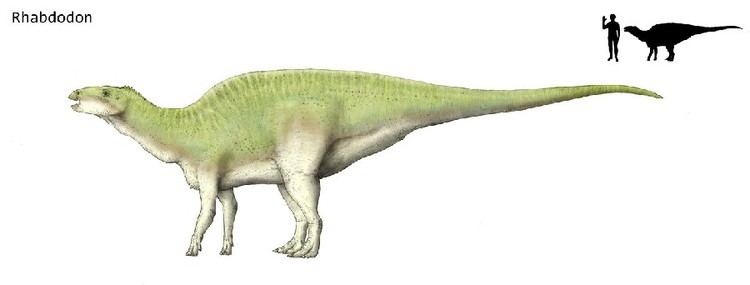Family †Rhabdodontidae Rank Genus | Class Reptilia Suborder †Ornithopoda Phylum Chordata | |
 | ||
Similar | ||
Rhabdodon (meaning "fluted tooth") is a genus of ornithopod dinosaur that lived in Europe approximately 70–66 million years ago in the Late Cretaceous. It is similar in build to a very robust "hypsilophodont" (non-iguanodont ornithopod), though all modern phylogenetic analyses find this ("Hypsilophodontia/tidae") to be an unnatural grouping, and Rhabdodon to be a basal member of Iguanodontia.
Contents
- 3d dinosaur adventure rhabdodon on the move
- DiscoveryEdit
- PaleobiologyEdit
- PaleoecologyEdit
- Villalba de la Sierra FormationEdit
- ClassificationEdit
- References

3d dinosaur adventure rhabdodon on the move
DiscoveryEdit

Rhabdodon priscus is the type species; another species, described in 1991, is R. septimanicus (Buffetaut and Le Loeuff), however these have on occasion been considered to be the same animal. Rhabdodon lived in Spain, France, and on Haţeg Island in Romania, and remains of a very similar dinosaur (femur and limb bone fragments) are also known from the Czech Republic. The Czech material is only identifiable as Rhabdodontidae indet., but the French material, currently referred as R. sp, has been on occasion referred to as a potentially distinct species. It was large compared to its nearest relatives, and indeed one recent paper ( Ősi et al. (2012)) determined it is larger than the basal rhabdodontid status; from this they suggested that it actually experienced gigantism on the "mainland"; and not insular dwarfism as previous suggested.
PaleobiologyEdit
Rhabodon was probably an important herbivore in Cretaceous Europe. Rhabdodon's predators may include the potentially dubious ceratosaur Tarascosaurus, and young may have been prey for Pyroraptor; thought adults where probably too big for either; as Tarascosaurus was around 2.5–3 m (7–10 ft), Pyroraptor around 2 m (6–7 ft), and Rhabdodon 6 m (18–20 ft).
PaleoecologyEdit
Rhabdodon priscus is known from a specimen from the Marnes Rouges Inférieures Formation. The material of Rhabdodon priscus includes a dentary and many other postcranial remains. More specifically, it is known from the Bellevue layer, which has produced many vertebrate fossils. Even though it produced many vertebrates, the formation only has a scarce record of plants and invertebrates. The non-dinosaurian vertebrates consist of Lepisosteus, an indeterminate turtle, and a crocodile. Dinosaurian fauna from the Marnes Rouges Inférieures Formation include Ampelosaurus, an animal classified as Dromaeosauridae indet., and an indeterminate ankylosaur. The bird Gargantuavis philoinos, and dinosaur eggs have also been recovered.
Another formation Rhabdodon priscus is known from is Gres de Saint-Chinian. Along with both Rhabdodon priscus, Rhabdodon septimanicus, dinosaur eggs, Nodosauridae indet. (previously known as Rhodanosaurus lugdunensis), Theropoda indet., Variraptor mechinorum, Avialae indet., Enantiornithes indet., and a possible Abelisauridae indet. are known from this formation.
Rhabdodon priscus is one of few vertebrates known from the Gres de Labarre Formation. The only other fossils from the formation belong to Ampelosaurus atacis and a Nodosauridae indet.
Villalba de la Sierra FormationEdit
Rhabdodon sp. is from the latest Cretaceous aged Lo Hueco region in the Villalba de la Sierra Formation. A study shows that the area around Lo Hueco dates to the late Campanian and early Maastrichtian, although a more recent study revised the later date to the latest Maastrichtian. The study showed that Lo Hueco was near the coast of the Tethys Sea, a large seaway through southern Europe and northern Africa. The area directly on the coast was shown to be a brackish-freshwater aquatic environment, with a muddy flood-plain beside it. Lo Hueco was found to be inside the flood-plain. The flood plain was found to have distributary channels of sand and terrigenous material.
Many dinosaurs have been found in the Villalba de la Sierra Formation, including Rhabdodon sp. They consist of possible Lirainosaurus remains, Ampelosaurus atacis, unknown basal euornithopods, probable ankylosaurians, one undetermined dromaeosaurine, and one unknown velociraptorine. The plants known from the formation are represented by carbonized branches and leaves. Invertebrates are solely known from bivalves and gastropods. Fishes from the formation include lepisosteids, and unidentified actinopterygians and teleosteans. Turtle fossils are very common, but only two different groups have been identified, the bothremydids Polysternon and Rosasia, along with an undetermined Pancryptodiran. Squamate lizards are known only from a few undetermined specimens, and eusuchian crocodiles are known from a specimen with similarities to Allodaposuchus and Musturzabalsuchus.
ClassificationEdit
The cladogram below is based on the analysis of Ösi et al. (2012):
